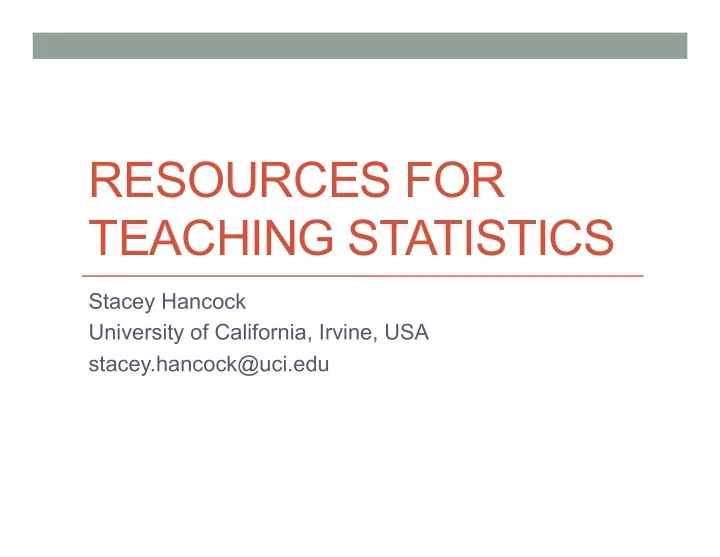

RESOURCES FOR TEACHING STATISTICS Stacey Hancock University of California, Irvine, USA stacey.hancock@uci.edu
My Background • Reed College, Portland, OR • Small liberal arts college, about 1500 students • Mathematics Department • Introductory statistics, probability, mathematical statistics • Clark University, Worcester, MA • Small liberal arts research university, about 2000 undergraduates plus graduate students • Mathematics and Computer Science Department • Introductory statistics for geography students, linear models for economics graduate students, probability and math. stat. • University of California, Irvine • Large research university, about 25,000 undergraduates • Statistics Department
College Introductory Statistics Course Guidelines for Assessment and Instruction in Statistics Education (GAISE) recommendations: 1. Emphasize statistical literacy and develop statistical thinking; 2. Use real data; 3. Stress conceptual understanding rather than mere knowledge of procedurs; 4. Foster active learning in the classroom; 5. Use technology for developing conceptual understanding and analyzing data; 6. Use assessments to improve and evaluate student learning.
Statistical Literacy, Reasoning, and Thinking Ben-Zvi and Garfield (2004): • Statistical literacy includes basic and important skills that may be used in understanding statistical information or research results. • Statistical reasoning may be defined as the way people reason with statistical ideas and make sense of statistical information. • Statistical thinking involves an understanding of why and how statistical investigations are conducted and the “big ideas” that underlie statistical investigations.
Seven Topics that Every Citizen Should Know about Statistics and Probability (Utts, 2003) 1. Cause and effect à can we conclude it? Observational studies versus randomized experiments. 2. Statistical significance versus practical importance. 3. The difference between finding “no effect” or “no difference” and finding no statistically significant effect or difference. 4. Common sources of bias in surveys and experiments, e.g., poor wording of questions, volunteer response, socially desirable answers.
Seven Topics that Every Citizen Should Know about Statistics and Probability (Utts, 2003) 5. Coincidences and seemingly very improbable events are not uncommon because there are so many possibilities. 6. “Confusion of the inverse” – the probability that you test positive given you have a disease is not the same as the probability you have the disease given you test positive! 7. Understanding that variability is natural, and that “normal” is not the same as “average.”
Projects • Emphasize the entire statistical process: forming a research question, experimental or sampling design, collecting data, analyzing data, summarizing and communicating results. • Allows students to explore topics they are interested in, especially those going into disciplines that conduct scientific research. • Good avenue for group collaboration. • Emphasize inventiveness and originality; strengthen ability of a student to teach himself/herself.
Projects • What works? • Students need regular feedback and several intermediate deadlines. • Provide students of well-written projects. • Clearly discuss project expectations. • Keep group sizes under five students. • Spend some time explaining how to use the library resources. • Include a “group peer evaluation.” • What doesn’t work? • Too broad or narrow topics. • Large group sizes (5+) • Unclear expectations or direction. • Lack of feedback or late feedback from instructor.
Where to Find Data? • http://www.ics.uci.edu/~staceyah/data.html Includes … • US Census data • World Bank economic data • Election data • Energy data • Environmental data • Links to more data links … • Many introductory statistics textbooks have their data sets freely available online, often with nice descriptions: • Mind on Statistics by Utts and Heckard • Introduction to the Practice of Staistics by Moore and McCabe • Workshop Statistics by Rossman and Chance • www.rossmanchance.com – Applets
News Stories • Chance News reviews current stories in the news that involve probability and statistics concepts and is freely available: http://test.causeweb.org/wiki/chance/index.php/Main_Page • Stats.org “checks out the numbers behind the news”, with lots of links to current news stories. • If you see something interesting, bookmark it! I have a folder dedicated to interesting news stories I can use in class. • e.g., “Student science experiment finds plants won’t grow near Wi- Fi router”, “When cheeseburger = walking, will we eat less?”, “On Facebook, you are what you ‘like’, Cambridge study finds”
Statistics Blogs in the US • Andrew Gelman’s statistics blog: http://andrewgelman.com/ • Nate Silver’s now famous statistics on politics: http://fivethirtyeight.blogs.nytimes.com/author/nate-silver/ • FlowingData data visualization blog: http://flowingdata.com/
www.causeweb.org • Have regular webinars on • teaching and learning statistics • highlights from the most recent issue of the Journal of Statistics Education • activities to use in class • Lecture examples, labs, homeworks and projects. • Data sets and how to use them. • Curriculum development. • Cartoons and “statistical art.” • Information on upcoming and past USCOTS and eCOTS conferences. • And much more …
Other Resources • Journal of Statistics Education: • http://www.amstat.org/publications/jse • Assessment Resource Tools for Improving Statistical Thinking (ARTIST) • http://app.gen.umn.edu/artist/ • Change Agents for Teaching and Learning Statistics (CATALST) • http://www.tc.umn.edu/~catalst/ • WWW Resources for Teaching Statistics • http://it.stlawu.edu/~rlock/tise98/onepage.html
Thank You! For all the links and to download slides: http://www.ics.uci.edu/~staceyah/
References • Ben-Zvi, D. and Garfield, J. (2004). Statistical literacy, reasoning, and thinking: Goals, definitions, and challenges. In J. Ben-Zvi and Garfield, D. (Ed.), The challenge of developing statistical literacy, reasoning and thinking (pp. 3-15). Dordrecht, The Netherlands: Kluwer. • Utts, J. (2003). What educated citizens should know about statistics and probability. The American Statistican , Vol. 57, No. 2, pp. 74-79.
Recommend
More recommend